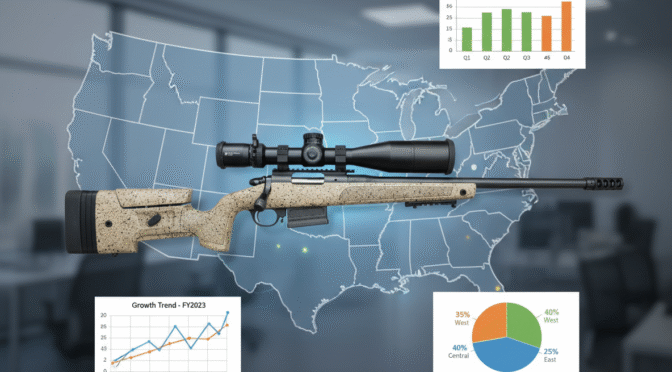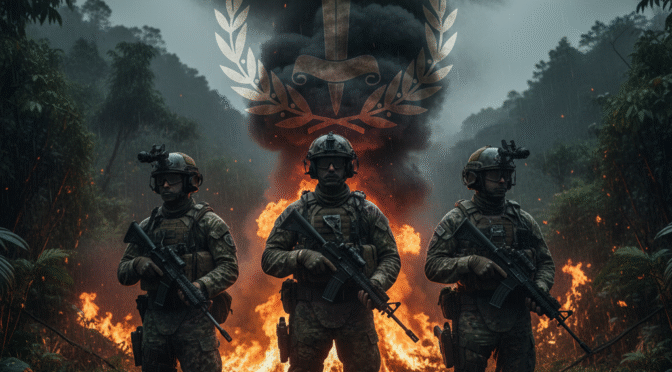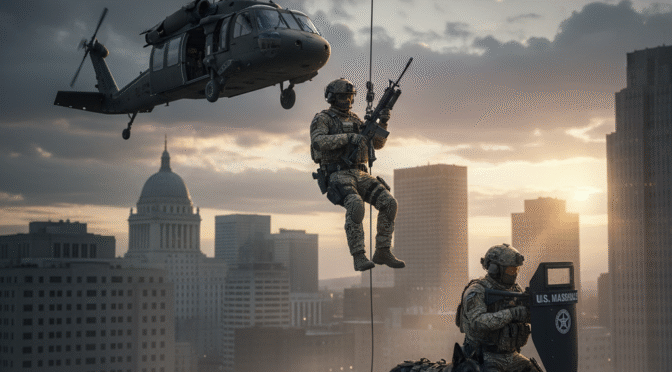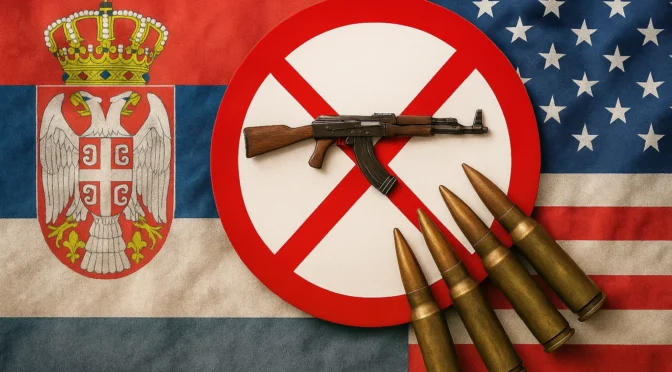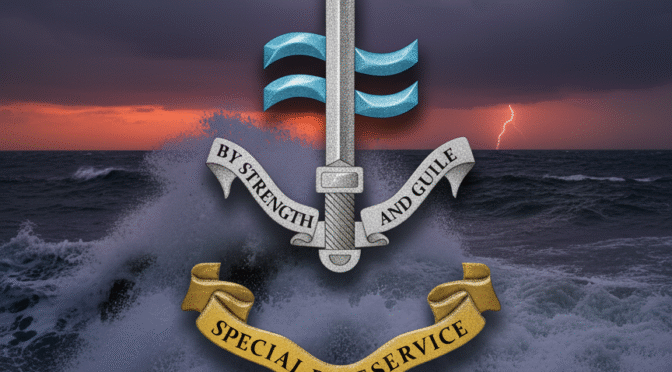The United States precision rifle market in Q3 2025 presents a landscape of intense innovation and focused growth, a stark contrast to the general cooling observed in the broader firearms sector.1 This dynamism is almost entirely propelled by the burgeoning popularity of long-range shooting disciplines, most notably the Precision Rifle Series (PRS), which has expanded its ranks to over 13,000 active competitors globally.2 This has cultivated a sophisticated and demanding consumer base that scrutinizes performance, features, and value with an expert eye. Market leadership is clearly stratified across price tiers. The entry-level segment (sub-$1,500) is a fierce battleground for value-driven brands like Howa, Savage, and CVA. The crucial mid-tier ($1,500-$3,000), which aligns with the popular “Production” competition class, sees a heated contest between Bergara, Tikka, and Daniel Defense, with legacy players like Ruger facing significant competitive pressure.3 At the high end ($3,000+), aspirational and professional-grade brands such as Accuracy International, Masterpiece Arms (MPA), and GA Precision define the pinnacle of performance.
Three key trends define the current market. First, the aluminum chassis system has become the undisputed standard, displacing traditional stocks with its superior rigidity, modularity via integrated ARCA and M-LOK systems, and near-infinite shooter adjustability.4 Second, the cartridge landscape continues to evolve. While 6.5 Creedmoor remains a versatile benchmark, faster and lighter-recoiling 6mm cartridges like 6mm Creedmoor, 6mm Dasher, and 6mm GT now dominate the competition circuit due to their ballistic advantages.2 Concurrently, new hunting-centric magnums such as the 7mm PRC are gaining significant market share for their long-range efficacy.7 Finally, the component ecosystem, built upon the “open-source” standard of the Remington 700 action footprint, is more critical than ever. This standard enables a vast aftermarket of triggers, chassis, and user-installable pre-fit barrels, effectively blurring the lines between factory, semi-custom, and full-custom rifles.8 A rifle’s commercial success is now inextricably linked to its compatibility within this ecosystem.
The Modern Precision Rifle Ecosystem: Market Landscape & Core Technologies
To accurately analyze the sentiment and performance of individual rifles, it is essential to first deconstruct the fundamental technological pillars and market structures that define the modern precision rifle. These elements represent a paradigm shift from traditional sporting rifles and form the basis of consumer expectations and manufacturer design philosophies.
The Anatomy of Precision: Four Pillars of the Modern Platform
1. Action & Footprint: The Heart of the System
The action is the core of any bolt-action rifle, but in the precision world, its external geometry—its “footprint”—is as important as its internal mechanics. The market is overwhelmingly shaped by the dominance of one particular standard.
The Remington 700 (R700) footprint has achieved a level of market hegemony that cannot be overstated.8 This is not a reflection of the quality of a contemporary factory Remington 700 action, which is often perceived by experts as requiring significant gunsmithing—or “truing”—to meet competitive standards.9 Instead, its dominance stems from the dimensional stability of its design; the action screw spacing, receiver diameter, and port shape have remained consistent for decades.8 This consistency has fostered a massive and stable aftermarket, creating an “open-source” platform where consumers can seamlessly upgrade chassis, stocks, triggers, and scope bases with near-universal compatibility.
This ecosystem has given rise to a class of elite “custom” actions from manufacturers like Defiance, Curtis, and American Rifle Company, which utilize the R700 footprint but are machined from superior materials to far tighter tolerances, offering premium features like integral recoil lugs and controlled-round feed out of the box.8 Furthermore, the advent of the “Rem-Age” barrel system—a concept borrowed from Savage that uses a barrel nut to headspace a pre-fit barrel on an R700-footprint action—has revolutionized the market. This system empowers end-users to perform barrel changes at home, a task that once required a skilled gunsmith, further cementing the R700 footprint’s dominance by democratizing customization.8
While the R700 footprint reigns, successful proprietary actions have carved out significant market share. The Tikka T3x action is the most prominent example, lauded for its exceptional out-of-the-box smoothness and accuracy, which has created its own dedicated, albeit smaller, aftermarket.11 This creates a strategic dichotomy: the “open-source” R700 model versus the “walled garden” approach of Tikka, where superior out-of-the-box performance is traded for more limited long-term modularity.
2. Stock vs. Chassis: The Ergonomic Revolution
The interface between the shooter and the rifle has undergone a radical transformation. Traditional wood and basic injection-molded polymer stocks, once the standard, are now largely confined to budget-tier or classic-styled hunting rifles. Their susceptibility to environmental factors like humidity and temperature, which can cause point-of-impact shifts, and their inherent lack of adjustability make them non-starters for serious precision work.13
The market has decisively shifted toward aluminum chassis systems. Data from the highest levels of competition shows a clear preference, with top PRS shooters choosing chassis over stocks by a two-to-one margin.5 This shift is driven by a clear set of advantages. The rigidity of machined aluminum provides a stable, flex-free platform for the barreled action, improving mechanical consistency and often negating the need for traditional glass bedding.4 Modularity is paramount; integrated ARCA-Swiss rails for rapid tripod and bipod attachment, along with M-LOK slots for accessories, are now considered non-negotiable features.4 Most importantly, chassis offer unparalleled adjustability. Tool-less controls for length of pull, cheek riser height and cant, and recoil pad position allow a shooter to achieve a perfect, repeatable fit, which is a cornerstone of accuracy.4
While chassis are dominant, a counter-movement exists at the high end of the market. Elite composite stocks from brands like Foundation and Manners remain highly competitive. These are not traditional stocks; they are precision-engineered systems. Foundation stocks are machined from a solid block of dense, stable Micarta, while Manners stocks often incorporate an aluminum “mini-chassis” bedding block.5 They offer the stability and rigidity of a chassis but with the ergonomics and feel of a traditional stock, appealing to a specific subset of top competitors who prefer their handling characteristics.
3. Caliber Trends: The Pursuit of Ballistic Supremacy
The choice of cartridge is a defining feature of a precision rifle’s intended purpose. The 6.5 Creedmoor was a revolutionary cartridge that established the modern benchmark for an efficient, low-recoil round with a high ballistic coefficient (BC), making long-range shooting accessible to the masses.6 However, within the hyper-competitive PRS/NRL circuits, it has been largely superseded by a new generation of faster, lighter-recoiling 6mm cartridges, including the 6mm Dasher, 6mm GT, and 6mm Creedmoor.2 These cartridges generate less recoil, allowing shooters to more easily spot their own bullet impacts and make faster follow-up shots—a decisive advantage in timed stages.
For hunting and hybrid applications, while the 6.5 Creedmoor remains immensely popular 6, a significant trend is the adoption of newer, non-belted magnum cartridges like the 7mm PRC and.300 PRC.7 These cartridges were designed from the ground up to fire modern, long, heavy-for-caliber, high-BC bullets, offering superior long-range energy delivery and wind resistance compared to legacy belted magnums like the 7mm Remington Magnum and.300 Winchester Magnum.
It is crucial to distinguish this mainstream market from the niche concept of “Precision Guided Firearms”.16 This term generally refers to systems integrating AI-driven targeting, laser guidance, and smart scopes, such as those developed by TrackingPoint. While technologically interesting, these are extremely high-cost systems primarily focused on military and defense contracts. Their market dynamics, including a forecasted 90.92% CAGR driven by defense procurement, are entirely separate from the civilian competition and hunting market analyzed in this report.16
4. The Rifle as a System: Beyond the Barreled Action
A modern precision rifle is not evaluated in a vacuum; it is the central hub of a complex system. Its market viability is critically dependent on its compatibility with established industry standards. The ability to accept AICS (Accuracy International Chassis System) pattern magazines is now a mandatory requirement. Likewise, compatibility with the vast ecosystem of aftermarket triggers, where brands like TriggerTech are frequently included as a factory standard, is a major selling point.17 Premium muzzle devices, such as those from Area 419, are often featured on factory rifles to enhance performance and value perception.15 Finally, optics mounting solutions are critical; an integrated Picatinny rail with a built-in 20 MOA cant is now an expected feature, facilitating long-range scope adjustment.7 The rifle and its optic are a symbiotic pairing; the mechanical accuracy of the rifle is only realized through the optical precision and tracking reliability of a high-quality, first-focal-plane scope.
Market Segmentation & Competitive Arenas
The market is best understood through three distinct price- and application-based segments.
- Entry-Level Precision (Sub-$1,500): This segment targets new shooters, hunters seeking a crossover long-range capability, and budget-conscious club competitors. The defining characteristic is value, with manufacturers making calculated trade-offs in action smoothness, finish, and chassis materials to meet the price point. A 1 MOA accuracy guarantee is typical. Representative models include the Savage Axis 2 Pro 18, Howa 1500 KRG Bravo 20, CVA Cascade LRH 21, and Mossberg Patriot LR Tactical.22
- Production & Mid-Tier Competition ($1,500-$3,000): This is the market’s center of gravity, catering to the core of the PRS/NRL competitive community and serious enthusiasts. Fully featured aluminum chassis, guaranteed sub-MOA accuracy, and the inclusion of premium components are standard. The action’s footprint, typically R700, is a key feature for future upgrades. This segment includes the Bergara B-14 HMR 23, Tikka T3x Tac A1 24, Ruger Precision Rifle 24, Daniel Defense DELTA 5 Pro 19, and Seekins Precision Havak PH3.18
- High-End & Semi-Custom ($3,000+): This tier is for Open Division competitors, collectors, and shooters demanding the absolute pinnacle of performance. These rifles are often built on elite custom actions or highly refined proprietary designs, using top-tier components like Bartlein barrels and chassis from MPA or Foundation. Flawless fit, finish, and reliability are the baseline expectations. These “halo” products, such as the Accuracy International AT-XC 25, Masterpiece Arms PMR Pro-II 26, and Proof Research Glacier Ti 27, drive brand perception for the entire industry.
Sentiment Analysis Methodology
This report’s sentiment analysis is a qualitative synthesis derived from a comprehensive review of authoritative sources. These include expert reviews from leading publications like Outdoor Life, Field & Stream, and PrecisionRifleBlog.com 2; unfiltered user-generated content from specialized online communities such as Reddit’s r/longrange and the AccurateShooter.com forums, which provide crucial long-term reliability data 3; and industry news from events like SHOT Show 2025.7
Sentiment for each rifle is aggregated and scored across a framework of key performance indicators (KPIs): Out-of-the-Box Accuracy, Build Quality & Reliability, Action Smoothness, Chassis/Stock Ergonomics & Adjustability, Value (Feature Set for the Price), and Aftermarket Compatibility. Market awareness is gauged via a “Total Mentions Index,” and sentiment is quantified as a percentage of Positive, Negative, and Neutral commentary synthesized from the source material.
Competitive Analysis: Sentiment & Performance of Top-Tier Rifles
An in-depth analysis of individual models reveals clear winners and losers within each market segment, driven by specific strengths and weaknesses that resonate with the educated consumer base.
The Entry-Level Arena (Sub-$1,500)
This segment is defined by intelligent compromise. Success hinges on delivering core precision features while managing costs. The most successful models achieve this by investing in a quality barreled action and a functional, adjustable stock or chassis, recognizing that the shooter interface is paramount for a new user learning fundamentals.
- Howa 1500 KRG Bravo: This rifle receives overwhelmingly positive sentiment and is widely considered a benchmark for value.20 The combination of a robust and reliable Japanese-made Howa 1500 barreled action with the intelligently designed KRG Bravo chassis creates a package that delivers the ergonomics and features—AICS magazine compatibility, adjustable cheek riser, vertical grip—of a much more expensive rifle.20 The primary trade-off is in ultimate precision; accuracy is consistently reported as good (~1 MOA) but not exceptional, a compromise most buyers in this tier willingly accept.30
- Savage 110/Axis II Platform: Savage rifles maintain a legendary reputation for outstanding out-of-the-box accuracy, frequently outperforming more expensive options.18 The user-adjustable AccuTrigger remains a significant selling point.18 However, this mechanical accuracy is severely undermined by persistent negative sentiment regarding the action. The Savage 110 action is notoriously rough, and even high-end models like the Elite Precision are plagued by well-documented feeding and ejection issues that often require user modification to resolve.32 This is a major flaw that tarnishes the brand’s reputation for performance.
- CVA Cascade LRH (Long Range Hunter): The Cascade LRH is praised for its impressive feature set at a sub-$1,000 price point, including a 20 MOA rail, radial muzzle brake, and adjustable cheek piece in a Cerakoted package.21 It is viewed as a strong contender in the budget long-range
hunting niche. This value comes with compromises in refinement; the magazine fit is described as “finicky,” and the cheek riser adjustment is crude, lacking fine control.34 - Mossberg Patriot LR Tactical: This rifle’s primary strength is its extremely aggressive pricing, making it one of the most accessible chassis-style rifles available.22 Its MDT-style stock is fully adjustable, and its trigger is excellent for the price. However, negative sentiment focuses on its design choices. At only 8 pounds, it is considered too light for a precision rifle, especially in magnum chamberings, leading to heavy recoil that makes spotting impacts difficult.22 Furthermore, its three-piece bolt construction exhibits noticeable “play,” detracting from the solid feel expected in a precision instrument.22
The Production Class Powerhouses ($1,500-$3,000)
This is the market’s most competitive and lucrative segment. Victory requires a masterful balance of performance, features, price, and aftermarket support. The shifting sentiment around the Ruger Precision Rifle (RPR) serves as a powerful case study. The RPR essentially created this market segment in 2015 by offering a chassis, adjustability, and solid accuracy at an unprecedented price.24 However, by 2025, its design has remained largely static while its price has increased. Consumers now frequently complain of a rough, “zipper”-like action, a buttstock that loosens over time, and feeding inconsistencies.3 It has been strategically outmaneuvered by competitors: the Bergara B-14 HMR attacks from below on value, the Tikka T3x Tac A1 from the side on quality and refinement, and the Daniel Defense DELTA 5 Pro from above on premium features.
- Bergara B-14 HMR (Hunting & Match Rifle): The HMR is the current standard-bearer for value in the mid-tier. Sentiment is overwhelmingly positive, centered on its smooth, high-quality R700-clone action, which grants it access to the industry’s largest aftermarket.23 The stock integrates a “mini-chassis” for rigidity, and the rifle is known for excellent out-of-the-box accuracy.12 The main critique is its weight, which makes it a phenomenal range or stationary hunting rifle but a burden for backcountry use.36
- Tikka T3x Tac A1 / UPR / CTR: The Tikka action is the undisputed gold standard for factory bolt smoothness, a feature highlighted in nearly every comparative review.3 This mechanical elegance is paired with exceptional, guaranteed sub-MOA accuracy and a level of fit and finish considered superior to most in its class.11 The primary drawback is its proprietary nature; the action footprint and magazines are unique to Tikka, limiting aftermarket choices compared to R700-pattern rifles.24 A specific and frequent complaint against the otherwise excellent Tac A1 model is the inclusion of a 0 MOA scope rail, a baffling choice that limits its long-range capability without an aftermarket replacement.12
- Daniel Defense DELTA 5 Pro: This rifle is perceived as successfully bringing custom-level features to a factory price point. It comes standard with premium, ready-to-compete components, including a Timney trigger and an Area 419 Hellfire muzzle brake.15 Its user-interchangeable, cold-hammer-forged barrel system is a significant technological and value advantage.19 Negative sentiment stems from early production models that suffered from weak extractor springs. While Daniel Defense reportedly corrected the issue, the initial reports damaged its launch reputation.19
- Ruger Precision Rifle (RPR): While credited as the platform that democratized the chassis rifle, sentiment has turned sharply negative. Once a value leader, it is now widely seen as “dated” and “overpriced” in the current market.3 Its functional accuracy is overshadowed by complaints about a rough action, a wobbly and difficult-to-adjust stock, and excessive bolt play.3
- Aero Precision Solus Competition: The Solus leverages Aero Precision’s strong reputation for quality manufacturing and value. The rifle is built around the Solus action, a well-regarded R700-footprint design that is also sold as a standalone component.23 User sentiment is positive, viewing it as a solid, “bang for the buck” option for entering PRS.38 As a newer entrant, it lacks the extensive track record of its rivals and is seen as a safe, competent choice in a very crowded field.
The High-End & Semi-Custom Frontier ($3,000+)
In this tier, flawless performance is the price of entry. Purchases are driven by brand equity, competitive pedigree, and demonstrable technological advantages. These are aspirational products, and the choice often comes down to which design philosophy a shooter subscribes to. Accuracy International trades on its legendary military toughness.25 Masterpiece Arms dominates the US competition scene by designing rifles specifically for that environment.5 GA Precision leverages its legacy as a premier custom builder.40 Each has a unique identity to justify its premium cost.
- Accuracy International AT-XC: The AT-XC is the benchmark for rugged reliability and precision, directly descended from world-renowned sniper systems.25 It consistently delivers some of the best accuracy in group tests, with flawless function and an exceptionally smooth, robust action.25 Its quick-change barrel system is a key feature for multi-caliber shooters.41 The only significant negative is its formidable price tag ($6,500+), which places it in a class of its own.25
- Masterpiece Arms (MPA) PMR Pro-II: This is the dominant rifle platform in American precision rifle competition.5 It is a purpose-built system, combining a top-tier custom action (Curtis) with the highly tunable MPA Matrix Pro-II chassis.26 Every feature, from the interchangeable grip system to the integrated weights for balance tuning, is designed for competitive advantage.26 At a price point around $2,500, it is considered an extraordinary value for a “ready-to-win” package.26
- GA Precision PPR (Production Police Rifle): This rifle carries the immense brand cachet of GA Precision, one of the industry’s most respected custom builders.40 Its primary selling point is a guaranteed 3/8 MOA accuracy, appealing to those who prioritize pure mechanical precision above all else.43 However, it draws significant criticism for its stock configuration. The Manners stock, while high quality, lacks features like an integrated ARCA rail, a weight system, and tool-less adjustments, which are now standard on rifles costing half as much.43 It is perceived by many in the PRS community as a superb barreled action in a chassis that is outdated for modern competition.
- Cadex CDX-R7 LCP: This Canadian-made rifle is praised for its exceptional machining, robust build, and innovative features.44 The action’s four-lug, 50-degree bolt throw is one of the fastest on the market, and its unique “roller bedding” system and use of top-tier Bartlein barrels contribute to its excellent accuracy.46 The folding stock mechanism is also considered a best-in-class design. Its main challenge is lower brand recognition in the crowded US market.
- Proof Research Glacier Ti: This rifle represents the pinnacle of the lightweight, long-range hunting rifle. It achieves a sub-6-pound weight by mating a titanium action with a carbon fiber-wrapped barrel and a carbon fiber stock.27 Despite its low mass, it delivers exceptional, guaranteed 1/2 MOA accuracy, and its fit and finish are described as “exquisite”.27 Its two primary drawbacks are its “hellaciously expensive” price ($7,500+) and a safety that does not lock the bolt closed, a potential concern for backcountry hunters.27 Its lightweight barrel is not designed for the high-volume fire of competition.48
Comprehensive Data Analysis: Top 20 Precision Rifles of Q3 2025
The following table synthesizes performance data and market sentiment to provide a rank-ordered snapshot of the competitive landscape. This matrix allows for a rapid, at-a-glance comparison of the leading rifles based on the metrics most critical to consumers: accuracy, features, and perceived value. The ranking is sorted by positive sentiment percentage, immediately highlighting the products that are winning in the court of public opinion—a crucial leading indicator of market health and product-market fit.
| Rank | Brand | Model | Segment / Action Footprint | Total Mentions Index | Sentiment (% Pos/Neg/Neu) | Accuracy & Consistency Summary | Chassis/Stock & Ergonomics Summary | Primary Application |
| 1 | Tikka | T3x (Tac A1/CTR/UPR) | Mid-Tier / Proprietary | 95 | 96% / 2% / 2% | Universally praised for exceptional out-of-box accuracy, often sub-0.5 MOA. Guaranteed sub-MOA. | Action is the smoothest factory bolt available. Tac A1 chassis is excellent but 0 MOA rail is a flaw. CTR/UPR stocks are functional. | Competition, Hybrid |
| 2 | Bergara | B-14 HMR | Mid-Tier / R700 | 98 | 95% / 3% / 2% | Excellent accuracy, easily sub-MOA with match ammo. R700 clone action is very smooth for the price. | “Mini-chassis” stock is rigid and adjustable. Great ergonomics but heavy for field use. AICS mag compatible. | Hybrid, Entry Comp |
| 3 | Accuracy Int’l | AT-XC | High-End / Proprietary | 78 | 94% / 1% / 5% | The benchmark for precision. Consistently the most accurate rifle in tests (sub-0.5 MOA). Flawless reliability. | Bomb-proof chassis with excellent ergonomics and quick-change barrel. Heavy. The standard by which others are judged. | Pro Comp, Tactical |
| 4 | Masterpiece Arms | PMR Pro-II | High-End / R700 (Curtis) | 85 | 92% / 4% / 4% | Built for match-winning accuracy with top-tier components. Performance is flawless. | The dominant PRS chassis. Infinitely tunable for weight, balance, and fit. Purpose-built for competition. | Pro Competition |
| 5 | Daniel Defense | DELTA 5 Pro | Mid-Tier / R700 | 82 | 88% / 8% / 4% | Sub-0.75 MOA guarantee. Excellent accuracy from CHF barrel. Smooth 3-lug action. | Superb chassis with integrated ARCA rail. Comes with premium Timney trigger & Area 419 brake. Early extractor issues hurt perception. | Competition, Tactical |
| 6 | Proof Research | Glacier Ti | High-End / R700 | 65 | 85% / 5% / 10% | Guaranteed 1/2 MOA. Incredible accuracy for an ultralight rifle. Carbon barrel heats quickly. | Ultimate lightweight hunting build. Titanium action, carbon stock. Flawless fit/finish. Safety doesn’t lock bolt. | High-End Hunting |
| 7 | Howa | 1500 KRG Bravo | Entry-Level / Proprietary | 80 | 84% / 10% / 6% | Good ~1 MOA accuracy. Not a tack-driver but consistent. Solid barreled action for the price. | KRG Bravo chassis is the star, offering features of rifles 2x the price. Best-in-class ergonomics for the budget tier. | Entry Comp, Hybrid |
| 8 | Cadex | CDX-R7 LCP | High-End / R700 | 55 | 82% / 6% / 12% | Sub-MOA with Bartlein barrels. Fast 50-degree bolt throw. Unique roller bedding system. | Excellent machining and robust, feature-rich folding chassis. Less known in US market but highly regarded. | Pro Comp, Tactical |
| 9 | Seekins Precision | Havak PH3 | Mid-Tier / Proprietary | 70 | 80% / 12% / 8% | Very good accuracy. Smooth 3-lug, 60-degree bolt throw action designed for modern high-pressure cartridges. | High-quality, adjustable carbon fiber stock. Feels like a semi-custom rifle. Excellent value. | Hunting, Hybrid |
| 10 | Aero Precision | Solus Competition | Mid-Tier / R700 | 68 | 78% / 10% / 12% | Good sub-MOA accuracy. Solid performer. | Well-made chassis with good features. Seen as a safe, solid, but not groundbreaking choice. Strong value proposition. | Entry Comp, Hybrid |
| 11 | GA Precision | PPR | High-End / R700 | 60 | 75% / 20% / 5% | Legendary 3/8 MOA accuracy guarantee. Superb barreled action from a top-tier builder. | Manners stock is high quality but lacks features (ARCA, weight system, LOP adjust) expected at this price for PRS. | Benchrest, Tactical |
| 12 | Savage | 110 Elite Precision | Mid-Tier / Proprietary | 75 | 65% / 30% / 5% | Excellent accuracy potential, often sub-0.5 MOA. | MDT ACC chassis is top-tier. AccuTrigger is great. Let down by a rough action and documented feeding/ejection issues. | Competition |
| 13 | Christensen Arms | MPR | Mid-Tier / R700 | 88 | 55% / 40% / 5% | Capable of sub-MOA, but carbon barrel strings badly when hot. Inconsistent QC on chambers/throats is a major complaint. | Chassis is attractive and lightweight. Let down by widespread QC issues (extraction, feeding, rough chambers). | Hybrid, Hunting |
| 14 | CVA | Cascade LRH | Entry-Level / Proprietary | 62 | 50% / 35% / 15% | Decent 1-1.5 MOA accuracy. Good for hunting ranges. | Packed with features for the price (brake, 20MOA rail, adj. cheek piece) but build quality is cheap (finicky mag, crude adjustments). | Budget Hunting |
| 15 | Ruger | Precision Rifle | Mid-Tier / Proprietary | 92 | 45% / 50% / 5% | Still capable of good accuracy, but no longer a standout. | Perceived as dated and overpriced. Rough “zipper” action, wobbly stock, and feeding issues are common complaints. | Entry Comp |
| 16 | Savage | Axis II Pro | Entry-Level / Proprietary | 58 | 40% / 30% / 30% | Good 1 MOA hunting accuracy. AccuTrigger is a plus. | Stock is an improvement over original Axis but still feels cheap and flimsy compared to chassis options. A pure budget play. | Budget Hunting |
| 17 | Mossberg | Patriot LR Tactical | Entry-Level / Proprietary | 50 | 38% / 42% / 20% | Acceptable accuracy, but lightweight design leads to excessive recoil, making precision difficult. | Stock is adjustable but overall rifle feels cheap. Three-piece bolt design has noticeable play. | Budget Hybrid |
| 18 | Browning | X-Bolt 2 | Mid-Tier / Proprietary | 52 | 35% / 25% / 40% | Good hunting accuracy. Not designed or perceived as a true precision/PRS rifle. | Excellent ergonomics for a traditional hunting rifle, but lacks the modularity and adjustability of a chassis system. | Hunting |
| 19 | Weatherby | 307 Range XP | Mid-Tier / R700 | 45 | 30% / 30% / 40% | Decent accuracy from a solid R700-clone action. | The stock is the main point of criticism, lacking the features and rigidity of competitors in the same price bracket. | Hybrid, Hunting |
| 20 | Christensen Arms | Evoke Precision | Mid-Tier / Proprietary | 65 | 25% / 45% / 30% | Sub-MOA guarantee, but brand’s overall QC reputation makes buyers wary. Shares concerns with the MPR. | Adjustable carbon fiber features are nice, but overshadowed by brand-wide negative sentiment on reliability and consistency. | Hunting |
Market Outlook & Strategic Conclusions
The precision rifle market is poised for continued evolution, driven by a feedback loop between a highly educated consumer base and manufacturers competing in a feature-rich environment. The following analysis provides forward-looking predictions and actionable recommendations for both manufacturers and end-users.
The Future of the Interface: Chassis & Stock Evolution
The dominance of the chassis system is set to continue, but the distinction between a “chassis” and a “stock” will become increasingly blurred. The market will see a proliferation of hybrid designs, like the KRG Bravo, and advanced composite stocks, like those from Foundation, that integrate core chassis features such as full-length ARCA rails, M-LOK compatibility, and internal weight systems. The next competitive frontier in chassis design is shifting from simple modularity to comprehensive tunability. The systems from market leaders like MPA and MDT already focus on allowing users to minutely adjust the rifle’s weight and balance point to mitigate recoil and stabilize the rifle on barricades.5 This advanced capability will inevitably trickle down to mid-tier offerings as a key differentiator.
The Cartridge Arms Race: Beyond the Creedmoor Era
The cartridge market will continue to bifurcate along application lines. For pure competition, where managing recoil to spot impacts is paramount, the trend toward hyper-efficient 6mm wildcat cartridges will persist among top-tier shooters. For the hunting market, the momentum behind the 7mm PRC,.300 PRC, and similar non-belted magnum cartridges will grow as they continue to displace older, less efficient magnum designs. These modern cartridges are purpose-built for the high-BC bullets that define long-range performance. However, the ultimate success of any new cartridge is dictated by ammunition availability. The meteoric rise of the 6.5 Creedmoor was a direct result of Hornady’s commitment to producing affordable, high-quality factory match ammunition. The next market-defining cartridge will be the one that earns similar large-scale industry support.
The Glass Ceiling: The Symbiotic Rise of Sophisticated Optics
As rifles become mechanically more accurate and capable, the optic increasingly becomes the limiting factor in the system. The future will see a greater integration of electronics, not in the sense of the autonomous “Precision Guided Firearm” 16, but through practical enhancements. Expect to see more scopes with integrated digital level readouts, shot counters for tracking barrel life, and seamless Bluetooth connectivity to handheld environmental sensors and ballistic applications. Manufacturers who design their rifles with optical integration in mind—for example, by including bridges for thermal and night vision clip-on devices 19—will hold a distinct advantage.
Blurring the Lines: The Collision of Factory and Custom
The term “semi-custom” is rapidly becoming the new standard for the mid-to-high-end market. Consumers now expect features once reserved for full-custom builds—premium triggers, high-end muzzle brakes, custom-quality actions, and match-grade barrels—in an off-the-shelf factory rifle. The success of the “Rem-Age” pre-fit barrel concept is the ultimate expression of this trend, having democratized a key component of the custom rifle building process.8 The most successful manufacturers will embrace this new paradigm, designing rifles not as closed products, but as open platforms for user-driven customization and enhancement.
Strategic Imperatives for Manufacturers
- Embrace the R700 Ecosystem: Developing a new proprietary action footprint is a high-risk, low-reward strategy unless backed by the brand power and R&D of a Tikka or Accuracy International. Designing around the R700 footprint provides consumers with immediate access to the industry’s largest aftermarket, a powerful purchasing incentive.
- The Chassis is Not Optional: In 2025, a rifle marketed for precision shooting without a feature-rich, ARCA-equipped, and fully adjustable chassis (or a high-end stock that functionally mimics one) is not a serious competitor.
- Fix Your Quality Control: In the digital age, a reputation for poor QC is a significant liability. The persistent negative sentiment surrounding Christensen Arms’ chambering and extraction problems 48 and Savage’s action and feeding issues 32 serves as a powerful deterrent for informed buyers, regardless of a rifle’s on-paper specifications or aesthetic appeal.
- Listen to the Competition Circuit: The PRS and similar leagues are the industry’s most effective R&D laboratories. The equipment and features used by winning competitors directly influence the purchasing decisions of the broader enthusiast market. MPA’s market dominance is a direct result of its deep integration with and responsiveness to the competition community.5
Guidance for the End-User: A Decision Matrix for Shooters
- The New Shooter (Budget <$1,500): Prioritize a quality action and an adjustable stock/chassis. Learning proper fundamentals with a rifle that fits you is more important than chasing marginal gains in mechanical accuracy. The Howa 1500 KRG Bravo is the top recommendation, offering best-in-class ergonomics and features that will grow with the shooter.
- The Aspiring Competitor ($1,500 – $3,000): This segment offers the best balance of price and performance. The decision is between the unparalleled out-of-the-box smoothness of the Tikka T3x Tac A1 and the superior aftermarket flexibility of an R700-pattern rifle like the Daniel Defense DELTA 5 Pro or Bergara B-14 HMR. For immediate performance, the Tikka is outstanding. For a long-term platform to upgrade and customize, an R700-based rifle is the more strategic choice.
- The “Buy Once, Cry Once” Pro / Enthusiast ($3,000+): For those seeking a direct path to a top-tier competition rig, the Masterpiece Arms PMR Pro-II offers the most performance and relevant features for the price. For those who demand absolute, cost-no-object reliability and military-grade toughness, the Accuracy International AT-XC is an heirloom-quality instrument. For the dedicated mountain hunter seeking the ultimate in lightweight performance, the Proof Research Glacier Ti exists in a class of its own.
If you find this post useful, please share the link on Facebook, with your friends, etc. Your support is much appreciated and if you have any feedback, please email me at in**@*********ps.com. Please note that for links to other websites, we are only paid if there is an affiliate program such as Avantlink, Impact, Amazon and eBay and only if you purchase something. If you’d like to directly contribute towards our continued reporting, please visit our funding page.
Sources Used
- U.S. Firearms Industry Today Report 2025, accessed August 13, 2025, https://shootingindustry.com/discover/u-s-firearms-industry-today-report-2025/
- 2025 – PrecisionRifleBlog.com, accessed August 13, 2025, https://precisionrifleblog.com/2025/
- How does the community feel about the Ruger precision rifle? : r/longrange – Reddit, accessed August 13, 2025, https://www.reddit.com/r/longrange/comments/1e0e78s/how_does_the_community_feel_about_the_ruger/
- Rifle Stock vs Chassis: Making the Right Choice | XLR Industries …, accessed August 13, 2025, https://xlrindustries.com/blogs/xlr-precision-rifle-blog/why-buy-a-rifle-chassis
- What The Pros Use: Best Rifle Chassis & Stocks – PrecisionRifleBlog …, accessed August 13, 2025, https://precisionrifleblog.com/2024/03/15/best-rifle-chassis-stocks-what-the-pros-use/
- 6mm Creedmoor vs. 6.5 Creedmoor – Rifle Caliber Comparison – Ammo.com, accessed August 13, 2025, https://ammo.com/comparison/6mm-creedmoor-vs-65-creedmoor
- The Best Hunting Rifles of SHOT Show 2025 – GearJunkie, accessed August 13, 2025, https://gearjunkie.com/hunting/best-hunting-rifles-shot-show-2025
- Why do none of the top 100 pros use a Savage style action? : r/longrange – Reddit, accessed August 13, 2025, https://www.reddit.com/r/longrange/comments/4291xu/why_do_none_of_the_top_100_pros_use_a_savage/
- trued 700 action or custom with 700 footprint? – Shooters’ Forum, accessed August 13, 2025, https://forum.accurateshooter.com/threads/trued-700-action-or-custom-with-700-footprint.3797245/
- Trued Rem 700 vs Custom Actions | Shooters’ Forum, accessed August 13, 2025, https://forum.accurateshooter.com/threads/trued-rem-700-vs-custom-actions.3971248/
- Buy Tikka T3x TAC A1 or Bergara B14 BMP in 6.5mm Creedmoor? | The Stalking Directory, accessed August 13, 2025, https://www.thestalkingdirectory.co.uk/threads/buy-tikka-t3x-tac-a1-or-bergara-b14-bmp-in-6-5mm-creedmoor.139047/
- (UPDATE) Need Help Deciding Tikka T3x TAC A1 vs. Bergara HMR | Rokslide Forum, accessed August 13, 2025, https://rokslide.com/forums/threads/update-need-help-deciding-tikka-t3x-tac-a1-vs-bergara-hmr.158117/
- Rifle Stock vs Chassis | Which is best?, accessed August 13, 2025, https://redhawkrifles.com/blog/rifle-stock-vs-chassis-which-is-best/
- What advantages does a rifle chassis offer over a conventional stock? : r/longrange – Reddit, accessed August 13, 2025, https://www.reddit.com/r/longrange/comments/193o65z/what_advantages_does_a_rifle_chassis_offer_over_a/
- Daniel Defense Delta 5 Pro – Coldboremiracle, accessed August 13, 2025, https://coldboremiracle.com/2024/01/15/daniel-defense-delta-5-pro/
- Precision Guided Firearm Market Forecast Analysis to 2033 – Global Growth Insights, accessed August 13, 2025, https://www.globalgrowthinsights.com/market-reports/precision-guided-firearm-market-106233
- TOP 7 Game-Changing Precision Rifles from SHOT Show 2025! – YouTube, accessed August 13, 2025, https://www.youtube.com/watch?v=PYozyYTYXM0
- The Hottest New Hunting Rifles from SHOT Show 2025, accessed August 13, 2025, https://www.petersenshunting.com/editorial/shot-show-best-new-rifles/514658
- Daniel Defense Delta 5 Pro Review – Warrior Poet Supply Co, accessed August 13, 2025, https://warriorpoetsupplyco.com/blog/daniel-defense-delta-5-pro-review/
- Review: Howa KRG Bravo – Guns and Ammo, accessed August 13, 2025, https://www.gunsandammo.com/editorial/review-howa-krg-bravo/359194
- Gun Of The Week: CVA Cascade Long Range Hunter – YouTube, accessed August 13, 2025, https://www.youtube.com/watch?v=s4NW5V7RBQw
- Mossberg Patriot LR Tactical Review: Stretching Your Dollar Long – Gun Digest, accessed August 13, 2025, https://gundigest.com/gun-reviews/rifles-reviews/mossberg-patriot-lr-tactical-review
- Best Rifles of 2025 [Range Tested & Reviewed], accessed August 13, 2025, https://www.pewpewtactical.com/the-best-rifles/
- 8 Best Long Range Rifles [2025]: For All Precision Shooters, accessed August 13, 2025, https://www.gunmade.com/best-long-range-rifles/
- The Best Rifles of 2025, Tested and Reviewed | Outdoor Life, accessed August 13, 2025, https://www.outdoorlife.com/gear/best-rifles/
- MPA’s PMR Pro II Truly a Precision Rifle Masterpiece – Guns.com, accessed August 13, 2025, https://www.guns.com/news/reviews/masterpiece-arms-pmr-pro-ii-rifle-review
- Proof Research Glacier Ti Rifle Review | Field & Stream, accessed August 13, 2025, https://www.fieldandstream.com/outdoor-gear/guns/rifles/proof-research-glacier-ti-rifle-review
- The Best Rifles of 2025, Tested and Reviewed – Field & Stream, accessed August 13, 2025, https://www.fieldandstream.com/outdoor-gear/guns/rifles/best-rifles
- New Precision Rifles for 2025 | An Official Journal Of The NRA – Shooting Illustrated, accessed August 13, 2025, https://www.shootingillustrated.com/content/new-precision-rifles-for-2025/
- Howa 1500 Review: A High-Value Barreled Action – Gun University, accessed August 13, 2025, https://gununiversity.com/howa-1500-review/
- Top 10 Centerfire Bolt-Action Rifles for 2025 – Gun Tests, accessed August 13, 2025, https://www.gun-tests.com/gun-tests-plus/top-10-centerfire-bolt-action-rifles-for-2025/
- Just picked this Savage 110 Elite Precision in 6.5 Creedmoor up : r/longrange – Reddit, accessed August 13, 2025, https://www.reddit.com/r/longrange/comments/1g0t7wn/just_picked_this_savage_110_elite_precision_in_65/
- BREAKDOWN: CVA Cascade LRH (Long Range Hunter) Overview – YouTube, accessed August 13, 2025, https://www.youtube.com/watch?v=DPtcnzuGlsc
- CVA Cascade Long Range Hunter 7mm Rem Mag Review – YouTube, accessed August 13, 2025, https://www.youtube.com/watch?v=LjB9Sxb2DW0
- Ruger Precision Rifle : r/longrange – Reddit, accessed August 13, 2025, https://www.reddit.com/r/longrange/comments/qkd0dt/ruger_precision_rifle/
- Tikka T3X vs Bergara B14 HMR | Rokslide Forum, accessed August 13, 2025, https://rokslide.com/forums/threads/tikka-t3x-vs-bergara-b14-hmr.138867/
- Daniel Defense Delta 5 Pro: Designed for Precision – Guns.com, accessed August 13, 2025, https://www.guns.com/news/reviews/daniel-defense-delta-5-pro-precision-rifle
- BEST PRECISION RIFLE on a BUDGET: the Solus | Tactical Rifleman – YouTube, accessed August 13, 2025, https://www.youtube.com/watch?v=8b-nmYdx8NM
- Most Accurate Rifle of 2025: Accuracy International’s AI AT-XC – YouTube, accessed August 13, 2025, https://www.youtube.com/watch?v=E_g5Bj1Cp38
- Testimonials – G.A. Precision, accessed August 13, 2025, https://www.gaprecision.net/testimonials
- AT-XC | BRAND NEW Accuracy International Rifle – YouTube, accessed August 13, 2025, https://m.youtube.com/watch?v=hMyzWItrg3Y
- Masterpiece Arms Matrix Pro II Chassis – YouTube, accessed August 13, 2025, https://www.youtube.com/watch?v=CAIQuUJgJvA
- PRS question. How often do you see GAP rifles? Their “Pinnacle” seems like it’s a great price for an off the shelf PRS rig. : r/longrange – Reddit, accessed August 13, 2025, https://www.reddit.com/r/longrange/comments/1ih7qd7/prs_question_how_often_do_you_see_gap_rifles/
- CDX-R7 LCP Series – Cadex Defence, accessed August 13, 2025, https://www.cadexdefence.com/products/cdx-precision-rifles/cdx-r7-lcp/
- Cadex CDX-R7 FPC Series Rifle – Customized to your specs (CDXR7-FPC), accessed August 13, 2025, https://charliescustomclones.com/cadex-cdx-r7-fpc-series-rifle-customized-to-your-specs-cdxr7-fpc/
- Cadex Defence CDX-R7 LCP – Blue Fieldsports, accessed August 13, 2025, https://www.bluefieldsports.co.uk/shop/cadex-defence-cdx-r7-lcp-2076
- PROOF Research Glacier TI | Long-Range Hunting Rifles – Evolved Ballistics, accessed August 13, 2025, https://evolvedballistics.com/rifles/glacier-ti/
- Christensen Arms makes some beautiful rifles and the MPR is no exception – Reddit, accessed August 13, 2025, https://www.reddit.com/r/longrange/comments/119xrcu/christensen_arms_makes_some_beautiful_rifles_and/
- Christensen Arms 7 PRC issues | Hammertime Forum – Hammer Bullets, accessed August 13, 2025, https://hammerbullets.com/hammertime/threads/christensen-arms-7-prc-issues.2492/
